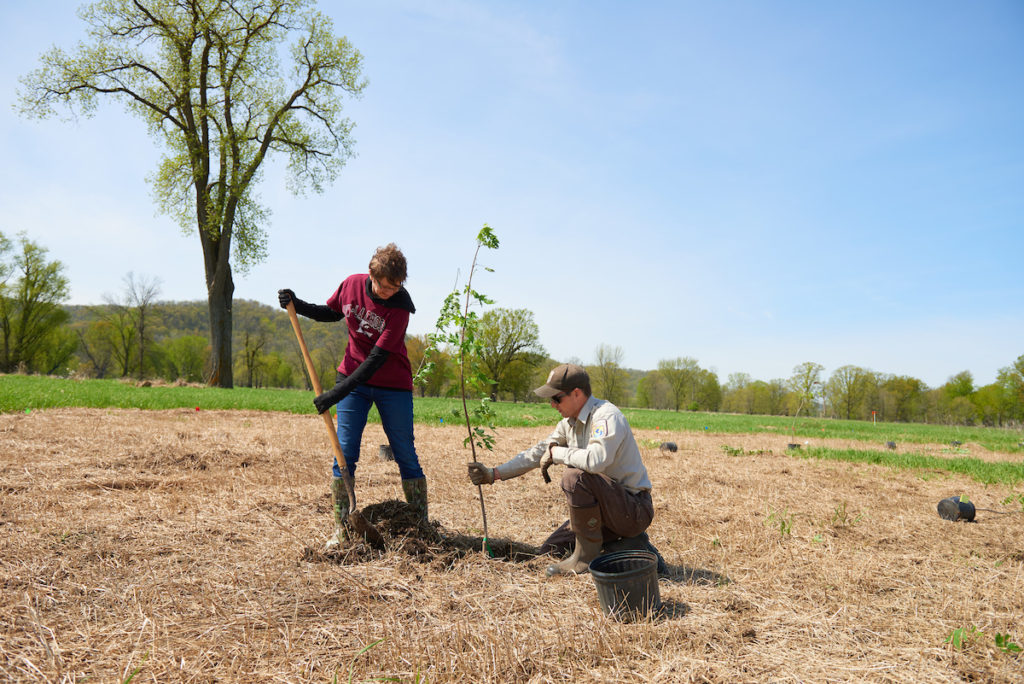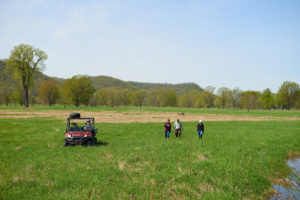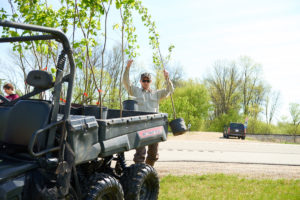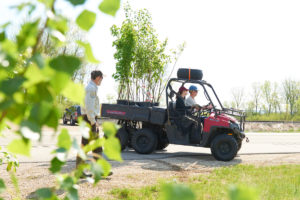
UW-La Crosse Professor Meredith Thomsen plants a tree at a reforestation site near La Crescent, Minnesota with help from UW-La Crosse graduate student Bill Kiser. Thomsen works with undergraduate and graduate student researchers to design her experiments, collect data and analyze and present results. She also uses her experiments and results for hands-on experiences in one of the classes she teaches.
On a highway south of La Crescent, Minnesota, a sea of grass waves in the spring breeze.
The open landscape is a stark contrast to the forest that once grew here along Hwy. 26. More than 100 years ago, the Upper Mississippi River Valley floodplain supported diverse native plants and trees — the perfect habitat for wildlife and birds.
Now, it is covered with reed canary grass. The most visible signs of life along this stretch of highway are scientists and land managers trying to figure out how to bring the forest back.

Thomsen walks with collaborators at a forest restoration site near La Crescent. A plant ecologist, Thomsen is interested in using her understanding of ecology to find the best ways to manage natural ecosystems. Results of her latest experiment will be shared with land management agencies to bring back floodplain forests, which are important habitat for wildlife and birds.
“Ultimately, we want to create a higher quality habitat for wildlife,” says University of Wisconsin-La Crosse biology graduate student Bill Kiser, who is also a wildlife biologist for the U.S. Fish and Wildlife Service.
Due to land use changes and the creation of the lock and dam system, large areas of forest in the river corridor have been lost, explains Meredith Thomsen, UWL professor of biology.
“We fear we will lose even more as aging forest sites are invaded by reed canary grass, which out-competes young trees,” she says.
Thomsen has been guiding UWL student researchers in a long-term study to reverse those trends and get forests reestablished in areas that are now dominated by the grass. Over the years, her work has attracted interest from land management agencies and environmental groups, and is now done in collaboration with Audubon Minnesota, the U.S. Fish and Wildlife Service, the U.S. Army Corps of Engineers, and the University of Minnesota.
Kiser’s graduate thesis project tests two different ways to decrease competition from reed canary grass using herbicides, so new trees can get established in the floodplain. In collaboration with University of Minnesota researchers, Kiser and other UWL researchers will also test three different ways of establishing young trees in the treated areas to see which method produces the highest survival rate and is most cost effective.
Results of the study will be incorporated along nearly 300 miles of the Upper Mississippi River Valley in reforestation efforts by land management agencies such as the U.S. Fish and Wildlife Service, U.S. Army Corps of Engineers and Department of Natural Resources.

Kiser, a UW-La Crosse graduate student and employee of the U.S. Fish and Wildlife Service, is helping to plant several thousand trees in southeastern Minnesota for the experiment. His graduate thesis will focus on which reed canary grass suppression method worked the best.
A grass-roots start
On a Wednesday morning, graduate student Kiser begins lifting trees onto an ATV to haul them to plots of land treated to reduce reed canary grass. The tree planting experiment will place several thousand trees in 64, one-half acre plots in southeastern Minnesota.
“It’s neat to be involved in something this big,” says Kiser.
Kiser’s research builds on a smaller-scale study, led by Thomsen and UWL graduate student Amber Miller-Adamany. As part of a three-year research fellowship, Miller-Adamany explored a variety of methods to restore floodplain forests with competition from reed canary grass.
“This shows the great continuity we have at UW-La Crosse,” says Miller-Adamany. “You don’t just do a thesis project to tuck it away in a library. We’re out in the real world getting results.”
The results are not only important to land management agencies. Environmental groups are also eager to bring the forests back. Audubon, a non-profit environmental organization dedicated to conservation, is helping fund and coordinate the tree-planting experiment.
“These forests are important for many species of birds and are critical for the Red-Shouldered Hawk and the Cerulean Warbler that rely on large tracts of forests,” says Tim Schlagenhaft, Upper Mississippi River program manager for Audubon. “We want to do what we can to help our partners that own and manage public land, and help them restore these forests.”

UW-La Crosse researchers work with collaborators from Audubon Minnesota, U.S. Fish and Wildlife Service, and the University of Minnesota to plant trees at a floodplain forest restoration site near La Crescent, Minnesota.
Schlagenhaft was delighted to have the expertise of UWL and U of M researchers to help design the study and ultimately analyze the results to find the best solution for reforestation.
Maria DeLaundreau, a graduate student from the University of Minnesota, and her graduate faculty mentor, will analyze tree growth while UWL researchers will focus on reed canary grass suppression data. Overall, DeLaundreau says their collaborative approach will yield a long-term solution instead of relying on herbicides that will only knock out the grass temporarily.
“This is really a regional problem, and people are looking for applicable results,” says DeLaundreau. “I think what we’re doing is great. All the collaborators add something to the project.”
Funding for the project was provided by the Minnesota Environment and Natural Resources Trust Fund and the Outdoor Heritage Fund, as appropriated by the Minnesota State Legislature.
